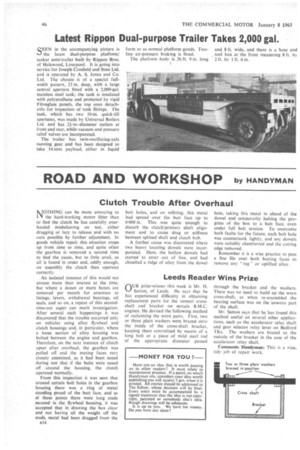ROAD AND WORKSHOP by HANDYMAN
Page 48

If you've noticed an error in this article please click here to report it so we can fix it.
Clutch Trouble After Overhaul
MOTHING can be more annoying to II the hard-working motor fitter than to find the clutch he has carefully overhauled misbehaving on test, either dragging or lazy to release and with no cure possible by further adjustment. In goods vehicle repair this situation crops up from time to time, and quite often the gearbox is removed a second time to find the cause, but to little avail, as all is found in order and, oddly enough, on assembly the clutch then operates correctly.
An isolated instance of this would not arouse more than interest at the time, but where a dozen or more boxes are removed per month for attention to linings, levers, withdrawal bearings, oil seals, and so on, a repeat of this secondtime-out caper can merit investigation. After several such happenings it was discovered that the trouble occurred only on vehicles using alloy flywheel and clutch housings and, in particular, where a loose section of alloy housing was bolted between the engine and gearbox. Therefore, on the next instance of clutch upset after overhapl, the gearbox was pulled off and the mating faces very closely examined, as it had been noted during test that if the bolts were eased off around the housing, the clutch operated normally.
From this inspection it was seen that around certain bolt holes in the gearbox housing there was a ring of metal standing proud of the butt face, and as at these points there were long studs secured in the flywheel housing, it was accepted that in drawing the box clear and not having all the weight off the studs, metal had been dragged from the
a14 bolt holes, and on refitting, this metal had spread over the butt face up to 0-008 in. This was quite enough to disturb the clutch/primary shaft alignment and to cause drag or stiffness between splined shaft and clutch hub.
A further cause was discovered where two heavy locating dowels were incorporated. Here, the hollow dowels had started to enter out of line, and had chiselled a ridge of alloy from the dowel
hole, taking this metal in ahead of the dowel and temporarily halting the progress of the box to a butt face, even under full bolt tension. To overcome both faults for the future, each bolt hole was countersunk lightly, and any dowels were suitably chamferred and the cutting edge removed.
Remember it is a wise practice to pass a fine file over both butting faces to remove any " rag " or uplifted alloy.




















































































































